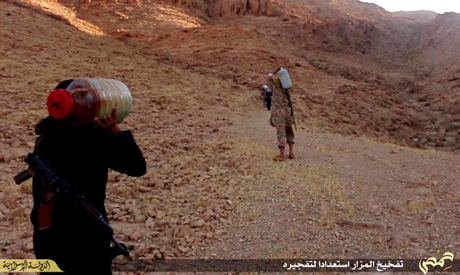
In this undated photo released on June 22, 2015, by a militant website, which has been verified and is consistent with other AP reporting, Islamic State militants carry plastic containers full of explosives as they prepare to blow up mausoleums, in the historic central town of Palmyra, Syria (Photo: AP)
Islamic State group militants have destroyed six archaeological pieces from the historic town of Palmyra that were confiscated from a smuggler, the group said.
An IS statement, released late Thursday, said the six busts were found when the smuggler was stopped at a checkpoint. The issue was referred to an Islamic court in the IS-held northern Syrian town of Manbij, which ordered that they be destroyed and the man be whipped.
Photographs released by the group show IS militants destroying the busts with large hammers. Another photo shows the smuggler being whipped.
The Britain-based Syrian Observatory for Human Rights said on Friday it was unclear if the busts were authentic or if the militants destroyed fake busts as a cover for the IS group's own antiquities smuggling.
While there is no firm evidence of the amount of money being made by the Islamic State group from looting antiquities, satellite photos and anecdotal evidence confirm widespread plundering of archaeological sites in areas under IS control.
IS captured the historic Syrian town of Palmyra in May from government forces. Many fear that the group will damage the town's archaeological sites as they did in neighboring Iraq earlier this year.
Palmyra's UNESCO world heritage site is famous for its 2,000-year-old Roman colonnades, other ruins and priceless artifacts. Before Syria's conflict began in 2011, tens of thousands of tourists visited the remote desert outpost, a cherished landmark referred to by Syrians as the "Bride of the Desert."
In March, IS members in Iraq razed 3,000-year old Nimrod and bulldozed 2,000-year old Hatra — both UNESCO world heritage sites.
The Sunni extremists, who have imposed a violent interpretation of Islamic law, or Shariah, in the territories they control in Syria and Iraq, believe ancient relics promote idolatry.
IS militants also recently destroyed a lion statue dating back to the 2nd century in Palmyra, said Maamoun Abdulkarim, the head of the Syrian government's Antiquities and Museums Department.
He said the statue, discovered in 1977, had stood at the gate of the town's museum, and had been placed inside a metal box to protect it from damage.
In Paris, the U.N. cultural agency's chief, Irina Bokova, condemned on Friday the latest destruction of Palmyra's cultural heritage, saying the actions "reflect the brutality and ignorance of extremist groups and their disregard of local communities and of the Syrian people."
"The destruction of funerary busts of Palmyra in a public square, in front of crowds and children asked to witness the looting of their heritage is especially perverse," Bokova added.
"These busts embody the values of human empathy, intelligence and honor the dead," she said. "Their destruction is a new attempt to break the bonds between people and their history, to deprive them of their cultural roots in order to better enslave them."
Short link: